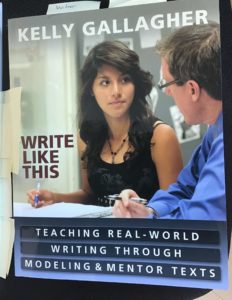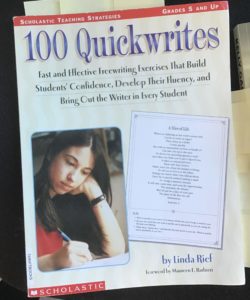I recently sat down with Jon Kornelsen, Grade 8 teacher at Clearspring Middle School. He has been making significant changes in his approach to writing instruction and is excited about what he is noticing in his teaching and his students’ learning. This stems from an impactful PD experience last fall.
Charmaine: Tell me about what you’ve been exploring with writing instruction this school year.
Jon: At our most recent MTS PD Day I attended a MATE (Manitoba Association of Teachers of English) session led by American high school teacher and author, Kelly Galagher. He spoke about writing, and how we need to model good writing for our students. He stated too often we tell them how to write instead of showing them how to write. Kelly has a book called Write Like This, so what I’ve been doing is using content from this book and information he told us to apply the idea of mentor texts with my Grade 8 students. You take a powerful piece of text, it could be a paragraph, a poem, a spoken word, a video, and you share it with the class. You then do a quickwrite response for a few minutes. The teacher models this first on the spot in front of their students, thinking aloud as they go. Students then proceed to do their own quickwrite in their ongoing journals. Next, the teacher revises their work using the RADR method; Replace, Add, Delete, Re-order, and then the students do the same after seeing the teacher do it. The idea behind this is that it transforms their writing because instead of just being told how to write, I am actually modeling in real time how to write well, they watch that, and then they have a chance to do their own.
Some days they don’t have to watch me write the whole time; you can share your writing afterwards but the idea is they consistently see their teacher writing. The foundational idea here is that you, the teacher, are the best writer in the room and so they need to be learning from the best writer in the room. The gym teacher would never just tell how to do a layup, they would show how to do it, come alongside the students and practice together. It is the same idea here.
And it’s been excellent. I’m loving it.
Charmaine: So just to clarify… the main ideas here are to have students writing often, watch an expert writer model the creation of drafts and do revisions, and bring in mentor texts as a foundation for that modeling?
Jon: Yes. I do variations of this, but that is the philosophy behind Gallagher’s model. We sometimes just do a quickwrite together for 3 minutes and then we share each other’s creations. I invite them to respond in writing to a short piece of text I’ve shown and read. They write something similar, or respond to just a word, or a phrase or a theme or emotion in that text. Then we revise for something I feel we need to further practice, like adding detail. They will watch me revise for this and then they will do it with their piece. They see me struggling with how to make things better, and they see me write silly things because I’ve got nothing better at the moment, but it shows them the difficulties of the creative process that go into bringing a writing piece to a polished final draft.
Sometimes, if there is a specific form of writing or style I want to highlight, I show them a mentor text and we read it aloud, and they try to incorporate this into a similar piece of their own. For example, we recently read a piece by Sandra Cisneros, a Latino author from the States, and she has a very fluid, beautiful way of writing with a lot of detail. In this piece she was writing about her family’s hair. Every member has different hair and it’s connected to their personality, so my students chose some family members and wrote about their hair, focusing on descriptive words that would bring out their personalities. It was great because I got writing out of students that I had seen having a hard time putting pen to paper before. I am seeing more and more glimpses of that and that’s very exciting.
Charmaine: There are early years teachers in Hanover using Katie Wood Ray as a resource for teaching writing with mentor texts, and this sounds like a middle years version of some of the same methods. Is Kelly’s book Write Like This specifically geared towards middle years teachers and students?
Jon: It is actually written with senior years in mind, but I am finding the ideas are completely applicable and adaptable to grade 8. In the past I haven’t really been interested in purchasing books about education practice because when I’m at home, I love reading fiction and history to let my mind take a break. But I was so impacted by Kelly’s presentation of ideas that I jumped into this book and have absolutely loved it. I also purchased Linda Reif’s book, 100 Quickwrites, because it fit so well with Kelly’s methods. I was so impressed with the short one page texts in her book. It is a rich collection of work by all these master writers in one place, but I found out a lot of the texts were written by school-age students. You can’t often tell which ones were written by professionals and which ones are by students because they are all such quality pieces.
Charmaine: Summarize the differences between how you taught writing in the past compared to how you teach writing now.
Jon: In the past, my writing units had tons of talking about writing, studying writing, and learning about writing and building criteria for writing, but not tons of actual writing. I felt we were talking around it so much more than actually doing it. I didn’t want to move away from using writing traits and building criteria around that, and this model still allows us to build this in, but it honours purposeful writing time so much more. Kelly says, and I’ve been talking to my students about it, too, that we need 40 minutes of writing across the curriculum every day, as a minimum. And 60 minutes of reading time. That’s quite ambitious. In his book he talks about how he includes reading, quickwrites, studying a writing trait, and producing a text all in one hour-long period. On paper my schedule doesn’t seem to allow for this, so I’ve had to be more flexible; but they are doing much more writing than they did before, and I’m liking the results that I’m seeing.
Charmaine: Explain some specific “good stuff” about this change.
Jon: We now have writing journals which I didn’t use before, so I sit down and read the drafts of some of my mid-level students and I’m seeing some of them really pushing their work to a new level that I hadn’t seen before.
Charmaine: What else?
Jon: It is forcing me to become a better teacher and a better writer because this is a new experiment for me. I typically like everything pre-planned and laid out, and so this has been a big stretch for me as I don’t know where things are going to go. Especially as you write personal texts. I’m coming across all different kinds of memories, emotions and experiences I’ve never thought about writing about before. And I’m loving how broader my own horizons are becoming. We are going to be writing memoirs in the late winter, and I am so excited because of the possibilities and directions this may lead. Even just by reading the first chapter of Kelly’s book I am able to see how much deeper and broader students can go with work like this.
Charmaine: Any other good stuff?
Jon: My students are highly engaged. Because we write in short chunks, it is easier for all students to dig in. And since they are building confidence in these shorter chunks, when we do spend 30 minutes or so on independent writing, students have no trouble focusing and staying on task. I don’t hear, “I don’t know what to write,” anymore because they’ve been filled up with ideas and quality examples.
Charmaine: Many educational experts say to focus on authentic writing topics and audiences. How do you reconcile this with the fact that, say, you are writing about a family member’s hair? Why do you think your grade 8 students are jumping into your topics so readily?
Jon: I think what I’ve been doing is powerful because when you write you explore who you are. Fundamentally, writing is a process of self-discovery. When I’m up there writing in front of my students, I’m sharing emotions and ideas and powerful thoughts that have never occurred to me before. It is new to me, too. I want them to be able to catch the idea that no, this won’t be on next week’s test, but you do need to be able to know and explore who you are as a human being. And writing is the best way to do this. It is showing them a different state to be in, it is away from their screens (I had a student last year who showed me her average phone time per day was 8 hours) where they have brain space to reflect and listen to what their minds and hearts are telling them.
Charmaine: So even when we are writing about trivial things, it is still about you. You are constantly subconsciously or consciously considering what you think at that moment, how you feel about something and what it means to you. You are constantly reflecting.
Jon: Yes, that is authentic reflection. Kelly talks about 6 different purposes for writing which are very authentic and real world: express and reflect, inform and explain, evaluate and judge, inquire and explore, analyze and interpret, and take a stand/propose a solution. Five of those six are very real world applicable and the express and reflect is a bit more airy fairy, but it is very important, too. Kelly says that to be a literate person you need to have a handle on all 6.
Charmaine: I like those 6 because they go beyond just different genres of writing. These make you think more deeply about why you are creating a piece of writing.
So…what about wondering stuff? What are you still questioning at this time?
Jon: I have 2 wonderings: 1) In one school year how do I teach all 6 purposes and a variety of forms in depth? Even just with the express and reflect right now, I could go all year with this. Easily. How do I bring in the other purposes meaningfully, because it could be overwhelming to try and squeeze them all in. 2) When I am writing in front of them, it takes a lot of time. I write slowly by hand. So to have them watch me write a paragraph, it takes several minutes. Kelly talks about writing a whole text in front of them, which could take upwards of 20 minutes or more. How do I do this? I don’t want to beat “modeling writing” to death and have them start rolling their eyes when I say it is time to watch me. The small chunks of modeling have been good, but what happens when I’d like to have them write an essay? How do I break that up?
Charmaine: How about next steps? What are you wanting to try next?
Jon: In the future we are going to look into showing emotion in our writing. How do you show sadness in writing, beyond writing, “I felt sad.” I’ve done something called “Show Don’t Tell” in the past and now I’m going to attempt to incorporate it into this new method. Students get to physically show, act out different emotions and this allows them to pick apart how we feel and act when we experience different things. They then translate this into their writing.
As we move into memoirs, we are going to do a bunch of quickwrites around memories. This time they are going to have many more opportunities to brainstorm and reflect on their memories, emotions and experiences through these quickwrites before narrowing it down to one that they want to form their memoir around. We are going to spend so much more time on activating.


